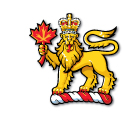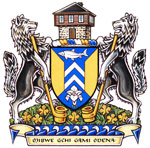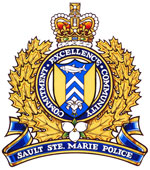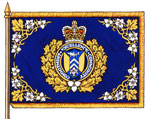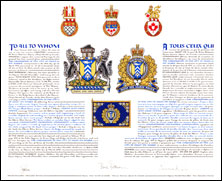- The Governor General of Canada

The contents of this Register are intended for research purposes only. The heraldic emblems found in the Register may not be reproduced in any form or in any media without the written consent of the Canadian Heraldic Authority and/or the recipient.
The Corporation of the City of Sault Ste. Marie
Sault Ste. Marie, Ontario
Grant of Arms and Supporters, with a Badge and Flag for use by the Sault Ste. Marie Police Service
March 20, 2015
Vol. VI, p. 493
Click on each image to enlarge. The blazon and symbolism for each element will accompany the enlarged image.
Blazon
Arms
Azure two chevronels Argent between two square flaunches rompu Or, in chief a whitefish naiant, in base a lily Argent;
Crest
The Clergue Block House proper;
Supporters
Two eastern wolves proper each supporting a hand crucible shafted Or and standing on a mount of pine branches and maple leaves issuant from waves proper;
Motto
OJIBWE GCHI GAMI ODENA;
Badge
The Arms within an annulus Azure edged Or inscribed COMMITMENT • EXCELLENCE • COMMUNITY in letters Argent, all within a wreath of maple leaves Or issuant from a trillium, the whole ensigned by the Royal Crown proper;
Flag
Azure the Badge cantoned by maple leaves Or and trillium flowers proper issuant from vines Or;
Symbolism
Arms
Blue, white and yellow are the colours of the city. The side segments and chevrons evoke the historic locks of the Sault Ste. Marie Canal. The centre section also resembles the cross section of a steel girder, thus alluding to the steel industry that was an important part of the city’s history. The whitefish is a species found in great numbers in the St. Marys rapids. The lily is a symbol of St. Mary and thus alludes to the city’s name; it also pays tribute to the city’s French heritage.
Crest
The Clergue Block House is a distinctive local historic structure. Originally a fur trade structure used by the Northwest Company, it was acquired and expanded by Francis Clergue, an American industrialist who developed the city’s industrial base in the 1890s.
Supporters
The eastern or timber wolf is a powerful local animal known for its gregariousness. The crucibles, held by long shafts, are tools used by steelworkers to gather molten steel; as such, they provide another reference to the city’s steel industry heritage. The base marks the significance of the local forestry industry, and the white-capped waves make a reference to the St. Marys rapids. The maple leaves indicate the city’s identity as a Canadian border municipality, their gold colour alluding to those in the coat of arms of Ontario.
Motto
This Ojibwe phrase, meaning “Settlement near the Ojibwe’s big lake”, was used with slightly different spelling in the original arms of the city.
Badge
Following the pattern of other municipal police service badges, this includes the arms of the city, a trillium and a wreath of maple leaves indicative of Ontario and Canada, the Royal Crown as a reference to the Crown as the source of justice, and a motto based on a slogan used by the service.
Flag
The symbolism of this emblem is found in other element(s) of this record.
Background
Canada Gazette Information
The announcement of the Letters Patent was made on October 3, 2015, in Volume 149, page 2337 of the Canada Gazette.
Artist Information
Creator(s)
Original concept of Bruce Patterson, Deputy Chief Herald of Canada, assisted by the heralds of the Canadian Heraldic Authority.
Painter
Eva Pilar-Cass
Calligrapher
Luc Saucier
Recipient Information
Civil Institution
Regional, Municipal etc Government
